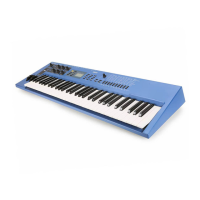12
How The CS1x
Generates Sound
Oscillators, Filters And
Amplifiers
Synthesizers rely on three key electronic components to imitate the
soundwaves of musical instrument voices, as well as create entirely new
sounds.
In traditional analog synthesis the source sound pitch is generated by an
oscillator
, its tone is created by a
filter
, and its volume is determined by
an
amplifier
.
AMPLIFIERSFILTERSOSCILLATORS
DETERMINES
VOLUME
CREATES
TONE
GENERATES
PITCH
! The oscillator generates sound wave vibrations at controllable speeds,
or frequencies, to create pitch. Synthesizer oscillators usually offer a
range of frequencies between 20 Hz and 20kHz, which is the range
of the audio spectrum that most human beings can hear. They also
usually offer various types of sound waveforms, such as sine, sawtooth,
and others.
" Musical instrument sounds are made up of the basic tone that we
clearly distinguish, plus additional harmonics, or overtones which
exist at each octave above the basic tone, but that we cannot distinctly
hear. The filter provides control over these harmonics. By manipulating
the filter's cutoff frequency, which decides where to delete—or cut
off—the overtones, and resonance settings, you can thus determine
the tone.
# An amplifier controls the volume of the tone. An envelope generator
(EG) determines the tone's volume over time, through attack, decay,
sustain and release settings.
AWM2 Waveforms
The CS1x takes the familiar concepts and functions of analog synthesis
and combines them with the state of the art in digital synthesis technology.
As such, it has hundreds of AWM2 waveforms, or digital recordings
("samples"), of all types of musical instrument and other sounds
programmed right inside—including everything from a violin bow
scraping a string, to a mallet striking a marimba, to a breath blowing
across a flute mouthpiece.
An AWM2 waveform forms the fundamental tone source of a CS1x voice;
the rest of the sound is contoured by the oscillator, filter and amplifier
settings. CS1x synthesis gives you enormous realtime and other control
over detailed aspects of all parameter settings.
In order to better understand what's actually happening to the sound as
you turn the Sound Control Knobs or modify other parameters, it is helpful
to first take a look at the key components which make up the physical
nature of sound.
The Nature
Of Sound
What is sound? If we could see sounds they would look like waves rippling
through the air at a constant speed with high frequencies bunched close
together and lower frequencies spread far apart.
Our ears are naturally designed to take these physical vibrations—or
sound waves—moving through the air around us at high, mid and low
frequencies, and interpret them as a dog barking across the street, someone
practicing a violin next door, a jet airplane screaming overhead, or rock
music on the stereo in front of you.
Generating
Electronic
Sounds
There are three basic elements which make up a sound:
•
pitch
, or how low or high it is
•
tone
, or what its overall quality is like
•
amplitude
, or how loud its volume level is
Before we take a look at how the CS1x generates and manipulates pitch,
tone and amplitude, lets first take a look at how these elements apply
naturally to acoustic musical instruments.
Acoustic musical instruments are specifically designed and carefully built
to produce precise sound characteristics when played—which is why a
violin always sounds like a violin, a piano always sounds like a piano,
and a flute always sounds like a flute.
A musician playing a finely crafted violin will scrape the bow across the
string at a certain intensity to generate violin sound waves at a certain
volume level (
amplitude
), and produce low or high notes based on
fingering positions (
pitch
). The vibrating strings and resonating wood, as
well as the playing style and technique of the musician, will determine
the overall quality of the violin's sound (
tone
).

